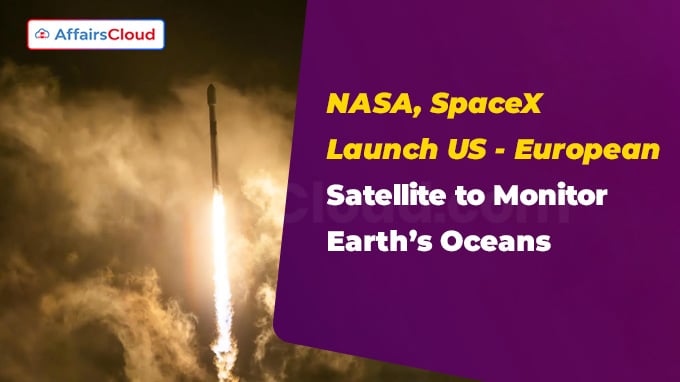In November 2025, ‘Copernicus Sentinel-6B’, an earth observation satellite, jointly developed by American space agency i.e. National Aeronautics and Space Administration (NASA) and European partners, was successfully launched aboard a SpaceX Falcon-9 rocket from Launch Complex 4 East at Vandenberg Space Force Base in California, the United States of America (USA).
- It is the second satellite in the Copernicus Sentinel‑6/Jason‑Continuity of Service(CS) mission launched by a Falcon 9 rocket, following the launch of Sentinel‑6 Michael Freilich in November 2020.
Exam Hints:
- What? Launch of Earth ObservationSatellite
- Satellite Name: Sentinel-6B
- Launch Vehicle: SpaceX’s Falcon-9
- Launched from: Vandenberg Space Force Base (in California, the USA)
- Purpose: Measure sea levels, atmospheric temperature, and humidity covering ~90% of oceans
- Joint Mission of: USA’s NASA, EU’s ESA, EUMETSAT and NOAA
- Predecessor Satellite: Sentinel-6 Michael Freilich (November 2020)
- Key Instruments (6):Poseidon‑4 SAR Altimeter, AMR‑C, GNSS‑RO, POD Package, REM, HRMR
About Sentinel-B Satellite:
Joint Mission: These sentinel satellites were developed as part of collaboration between NASA, European Space Agency (ESA) of the European Union (EU), European Organisation for the Exploitation of Meteorological Satellites (EUMETSAT), and the National Oceanic and Atmospheric Administration (NOAA).
- The project received funding from the European Commission and technical support from the French space agency CNES (Centre National d’Études Spatiales).
Key Objective: Sentinel‑6B, together with its twin Sentinel‑6 Michael Freilich, will collect data covering about 90% of the Earth’s oceans, with the objective of measuring global sea levels, atmospheric temperature, and humidity.
Orbit & Reference Role: When Sentinel‑6B reaches its designated orbit, it will follow Sentinel‑6 Michael Freilich by 30 seconds for cross-calibration.
- Afterward, Michael Freilich will move to a different orbit, and Sentinel‑6B will assume the role of official reference satellite, orbiting Earth 13 times a day at 830 miles (1,336 km).
Revolution: The latest version of Sentinel series satellite will orbit Earth at a speed of 7.2 kilometer per hour (km/hr), completing one revolution every 112 minutes (mins).
Key Equipments: This newly launched ocean-tracking satellite is equipped with 6 science instruments that will continue to measure ocean height and collect other important information about the earth’s ocean.
- Poseidon-4 Synthetic Aperture Radar (SAR) altimeter: It will be used to monitor seawater height, and to measure major wave height and wind speed.
- Advanced Microwave Radiometer for Climate (AMR‑C): Adjusts altimeter readings for atmospheric water vapor.
- Global Navigation Satellite System – Radio Occultation(GNSS‑RO) – Measures atmospheric temperature, pressure, and humidity.
- Precise Orbit Determination (POD) Package: Comprises Global Navigation Satellite System(GNSS) receiver, Doppler Orbitography and Radiopositioning Integrated by Satellite(DORIS), and Laser Retroreflector Array for precise satellite positioning.
- Radiation Environment Monitor (REM): Detects space radiation impacting instruments.
- High‑Resolution Microwave Radiometer (HRMR): Assists in atmospheric correction for accurate sea-level data.
Significance: The satellite will improve oceanographic data collected over the last 30 years and help in predicting extreme weather events with precision.
About National Aeronautics and Space Administration (NASA):
Acting Administrator- Sean Duffy
Headquarters- Washington DC, the United States of America (USA)
Established- 1958





